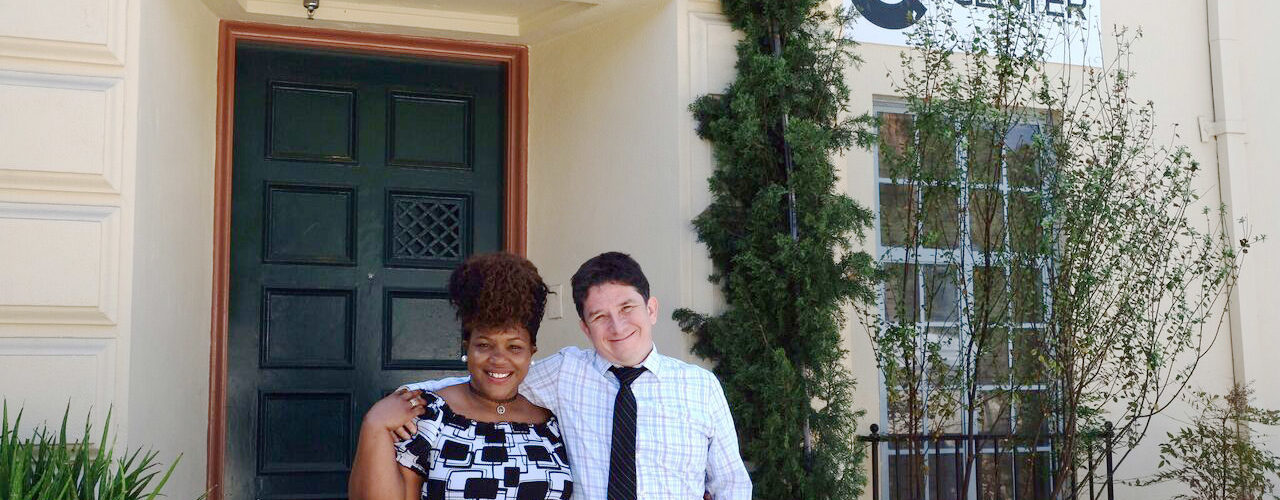Rudy Salinas is tired. Last night, at two in the morning, he received a call from one of his clients, asking for help breaking into her own car. She’d been sleeping in one of the few “safe parking lots” spread throughout Los Angeles, which are patrolled by security and thus significantly safer than parking on any old corner. (They’re also rare: a mere twenty such spaces exist in Hollywood and North Hollywood.) But then she got locked out.
“This is a nonstop job,” Salinas says, matter-of-factly. “It is a job that does not have a whistle that blows at five.”
Salinas has been working with unhoused people in L.A. for 17 years—and has seen, up close, just how much the county’s response to the crisis has evolved. In the beginning, he would tag along with church groups, handing out PB&J sandwiches and bottled water to the folks he found on streets near his San Gabriel home. Today, as head of outreach for a drop-in service agency called the Center in Hollywood, he works with sophisticated teams that include clinicians capable of prescribing psychiatric drugs.
“If you would have told me that that was possible a decade and a half ago, I wouldn’t have believed it,” he says.
The Heartbreak of Waiting
But there are also more extreme economic forces with which to contend. Rent increases have pushed thousands more Angelenos onto the streets, where resources are still stretched thin due to political gridlock and NIMBY resistance. “The conveyor belt that creates homelessness is moving faster every day,” says Salinas.
“It’s heartbreaking at times to tell them, ‘I just need you to wait two months.’ And then, ‘I just need you to wait two more months.’”
Instead of building more housing, politicians and NIMBYs often hold up the city’s progress, which has had a huge effect on Salinas’ clients. It can be wrenching to watch from the sidelines as unhoused people get shuffled through the system, waiting fruitlessly for a spot in supportive housing to open up.
His team follows unhoused people, sometimes for years, from emergency rooms to jails to courts. “It’s heartbreaking at times to tell them, ‘I just need you to wait two months.’ And then, ‘I just need you to wait two more months.’”
But then there are the success stories. At the Center, Salinas works alongside social workers and case-managers to lessen the overwhelming isolation of folks who have been living on the streets for years. Every morning, he and his colleagues meet with Center visitors for coffee before they head into classes for yoga, art, recovery and mindfulness & meditation.
“We’re at a point where our county has realized that these kinds of spaces are crucial to healing.”
His coworker, Malinda Estrada, says she can see the effect these meetings have on her clients. “You’re working on their hearts, you’re working on their minds, you’re showing them love and patience.”
“We’re at a point where our county has realized that these kinds of spaces are crucial to healing,” says Salinas. “The problem is that the public still has a ways to go toward understanding why these places need to be built in their neighborhoods.”
The Fight Ahead
Both have seen the huge effect it can have on someone when they finally find a home. In addition to all the things you’d expect—the lifting of crushing dread around where to sleep at night—there’s a lightness to their step. Malinda says she can spot housing recipients by their demeanor alone.
“There’s no price tag on it. It is unequaled,” says Salinas about moving someone into a new home. “It’s like seeing a unicorn on a rainbow flying in a rocket ship. It’s a feeling of having been witness to a very key moment, like a wedding or a birth.”
“These people didn’t come out of the womb homeless,” adds Estrada. “They had a home at one point. Why wouldn’t they want to get back to that and be able to go to their kitchen and cook something or take a bath?”
“We know how to handle this problem. Let’s just do it.”
She has a message for residents wary of building more supportive housing in their neighborhoods. “We can’t build here, we can’t build there. Why is everything so difficult? We know how to handle this problem. Let’s just do it.”
This message—impatient for some humanity to win over greed and apathy—comes through loud and clear in “The Advocates,” a new documentary that details Salinas’ work with L.A.’s unhoused residents over the past decade.
The film is screening this month at theaters across L.A. Check our calendar for a showing in your area and find out what dedicated people are able to achieve for our most vulnerable residents.



